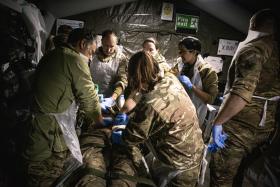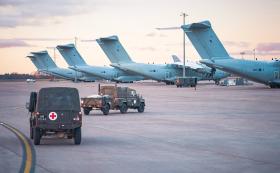From moving casualties by helicopter to receiving supplies by parachute, airborne medics have practised the skills key to their role in responding to global crises.
On a wintry Salisbury Plain, 16 Medical Regiment was put through its paces on Exercise Winged Serpent. The two-week-long manoeuvres (15-26 Jan) saw the medics on a simulated short notice deployment to support an ally invaded by a hostile neighbour.
The unit flew in on an RAF A400M transport aircraft, to then move medics and their supplies by helicopter to establish treatment facilities across the training area. The medics practised treating casualties from care at the point of wounding to life saving damage control surgery, as well as looking after troops’ general health needs. The range of their capabilities meant the medics treated simulated patients with everything from toothache to catastrophic blast injuries.
As well as their skill at treating casualties, the unit was tested on how it communicates and manages supplies on the battlefield and keeping treatment facilities mobile and camouflaged to present less of a target.
The training was to confirm that the regiment’s 23 Medical Squadron is ready to be on very high readiness for operations as part of 16 Air Assault Brigade, the British Army’s global response force.
Major Sean Mason, Officer Commanding 23 Sqn, said: “The challenge of high readiness operations requires robustness and agility, both mental and physical. Our role is to get there first, often without fully knowing the situation we’re facing and what we’ll have to do.
“What we offer is a world-leading military medical capability through the skills and experience of our soldiers; the range of treatment we can deliver; our readiness to deploy around the world; and our ability to manoeuvre on the battlefield.”
Colchester-based 16 Med Regt deployed on the evacuation of Kabul in 2021 and the evacuation of Sudan and earthquake relief efforts in Turkey in 2023.
“The team we have is pretty special, with a lot of experience acquired through many different situations,” Maj Mason said. “Amid rain, wind and snow they’ve really shown how well they can adapt to and perform in a warfighting scenario.”
The unit’s personnel - including consultant orthopaedic surgeons, dentists, biomedical scientists and combat medical technicians (CMT) - are specially trained and equipped to deploy by parachute, helicopter, or airlanding.
Private Jodie Webb is a CMT in a Pre-Hospital Treatment Team (PHTT), made up of a doctor, a nurse and CMTs working from a tent close to the battlefield.
“We are basically the first formal medical facility that a casualty will come to,” she said. “We can treat minor injuries and illnesses or stabilise a casualty if they need to go back for more treatment.
“The PHTT can be quite a high-pressure environment, particularly when we’ve had mass casualty incidents and it’s all hands on deck to treat patients. You need to be robust and ready for anything, but the more training we do as a team the better we’ve become. We’ve got to know each other and the kit we’re using, and that does help you stay calm when it gets busy.”
Corporal Anthony Siddall is a CMT working in the regiment’s Medical Reception Station, which combines the services of civilian GP and dental surgeries with a small ward.
“For me the reward of being a medic is being there to help someone when they really need it,” he said. “Our role is to be ready to go anywhere in the world and do that, whether it’s a warfighting or humanitarian situation.
“This training has been pretty fast-paced - we flew in and had patients to treat as soon as we were on the ground - and that’s a good reflection of what we’d have to do on an operation.”
The exercise culminated in the medics supporting an attack on the Copehill Down training village by 4th Battalion The Royal Regiment of Scotland.
4 SCOTS’ Colour Sergeant Callum Marr said: “As infantry soldiers, it’s been very reassuring to see the full extent of the medical chain. We know that when we’re on operations and anything happens, we’re in the best hands.”
Source:
British Army News Release Images taken by Cpl Brown, British Army.
Read More






Latest Comments
There are currently no comments for this content.
Add Comment
In order to add comments you must be registered with ParaData.
If you are currently a ParaData member please login.
If you are not currently a ParaData member but wish to get involved please register.